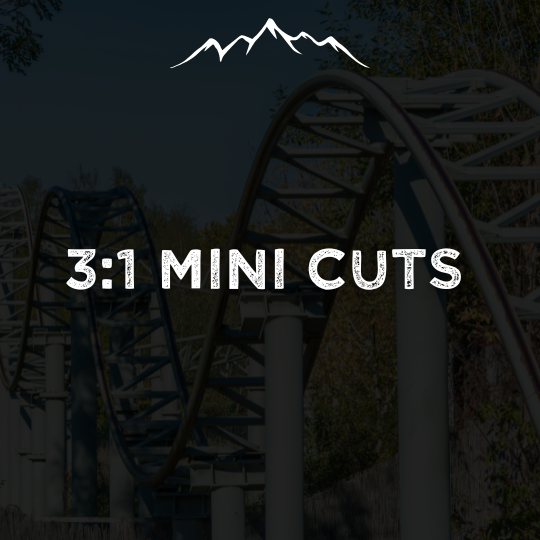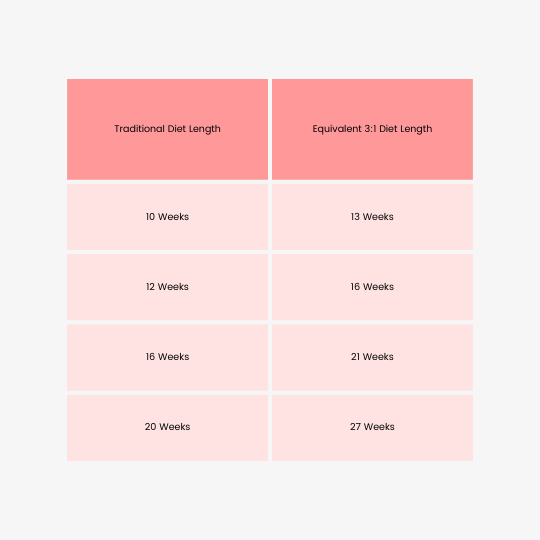3:1 mini cuts
An overview of whether 3-week on, 1-week off dieting is right for you.
What are 3:1 fat loss Phases?
Let's define the 3:1 fat loss phases to level-set the terminology here.
3:1 Fat Loss phases are when you intentionally plan to diet for three weeks, take a one-week maintenance break, and repeat until your desired goal is reached.
Seems like a great idea, right? You only need to diet 75% of the month and get the desired results. Let’s walk through a few of the drawbacks you should consider before starting a 3:1 diet.
*Note: While we’re using 3:1 here as the primary example, this also applies to 2:1-5:1 or anything similar where calories are undulating.
Drawback #1: maintenance is a range
One of the #1 complaints we’ll hear from people who don’t understand that maintenance is a range is: “I cut 300 calories, and after a few weeks, nothing happened. Calorie deficits don’t work for me”
This is because maintenance is a range, and they often cut from the top of their maintenance, barely breaking into deficit calories.
In reality, they needed to cut 300 calories from the bottom of the range to elicit the change they were expecting.
Drawback #2: it takes 3-4 weeks to ensure its working
Have you ever started a deficit and seen that initial woosh from cutting out sodium and carbs?
90% of that is water.
Some people experience a multi-pound flush in the first 10 days by lowering the available resources for glycogen retention. In your first 1-2 fat loss phases, you must assess trends 3-4 weeks after the initial water flush.
The assessment at the 3-4 week mark is critical to ensure you are below the bottom of your maintenance range at the intended rate of loss
Drawback #3: Extended time dieting
This may be obvious on the surface, but 3:1 dieting increases total time spent dieting by a 3rd. 1 week off
As it stretches on, a five-month fat loss phase turns into nearly seven months. The opportunity cost of those cumulative weeks could be ones that are better spent building muscle or other endeavors instead.
Bonus myth #1: Diet breaks don’t stop adaptation
Diet breaks, or 3:1 dieting, have often been touted as a way to keep your metabolic rate high and avoid metabolic adaptation.
A 2024 meta-analysis by Poon et al (2024)* showed only a 50-calorie difference in metabolic adaptation between groups either continuously dieting or taking intermittent diet breaks.
Granted, some people may benefit from a psychological break from dieting, and others may feel that adherence to the diet is harder after a maintenance break.
*PMID: 38422372
Pulling it together:
If you don’t know the bottom end of your maintenance range and plan a 3:1 diet, you may end up spinning your wheels and not realizing it until a few months later.
This is because, in each 3-week diet phase, you’ll experience the initial flush from rebalancing sodium and glycogen. You may perceive that the deficit is working more than it really is.
Every fourth week, you go back to maintenance and replenish the carbs and glycogen to do it again.
Thinking you’re getting a ~0.6-0.8lb/week rate of loss when in reality, it’s closer to 0.2-0.3lbs/week.
Frustrating.
So who might want to use it?
All this to be said, we’re not fully against 3:1 dieting. However, it can absolutely obfuscate whether the deficit is really working or not. If you are looking to employ it, here are a few considerations:
Know Your Maintenance Range: For 3:1 to be effective, you need to be sure that your targets are set correctly. So, you’ll likely need to complete 6-8 weeks of continuous fat loss first before transitioning over.
No Timeline/significant social schedule: Don’t have a timeline for fat loss? Are you okay with extending the total time spent dieting by 33%? Do you have a serious social engagement or work travel schedule? We could employ this strategy if there's truly no better time for fat loss in the year.
Maintenance is dialed: We are most sensitive to fat regain when we surplus in the midst of a deficit. These breaks must truly be at maintenance and tracked.





